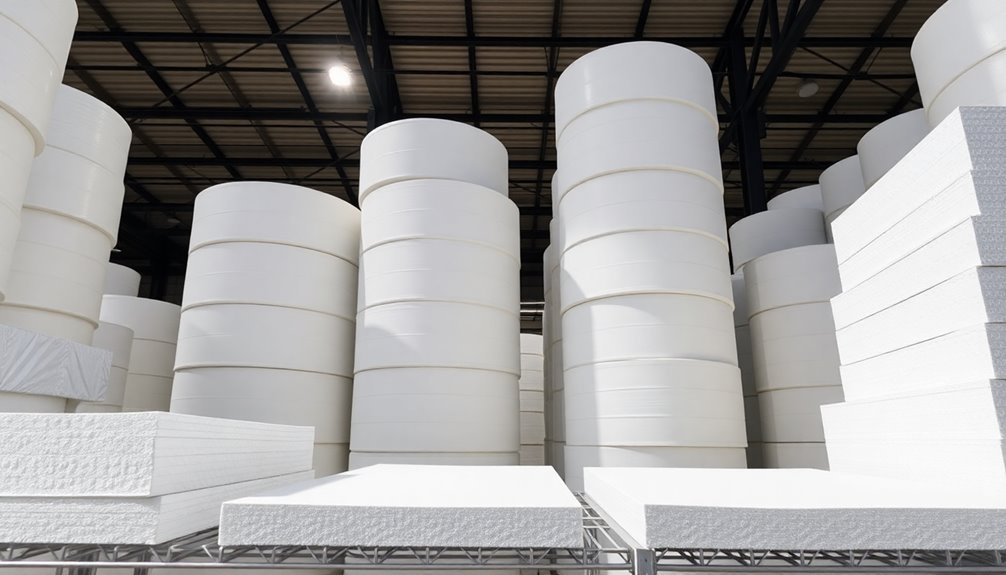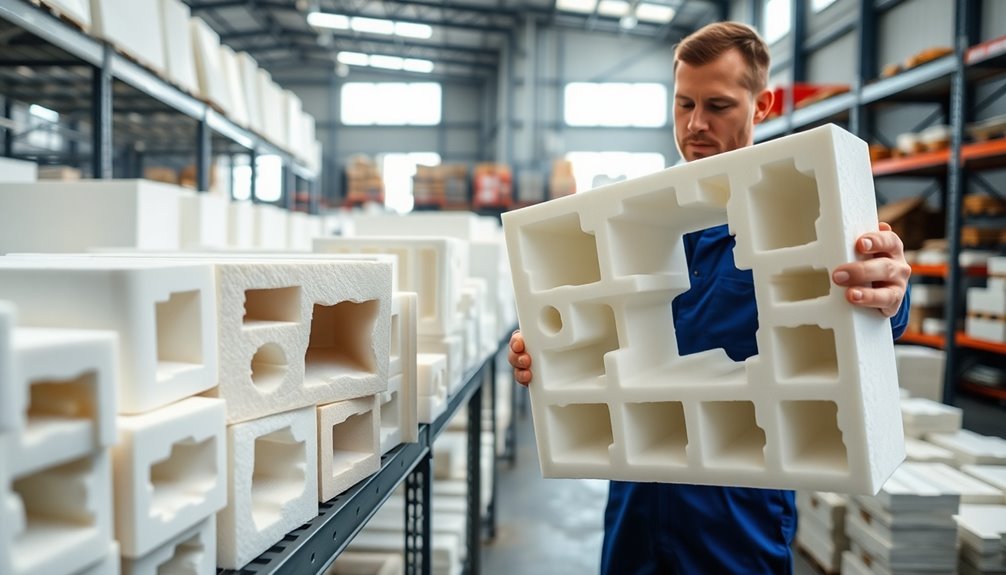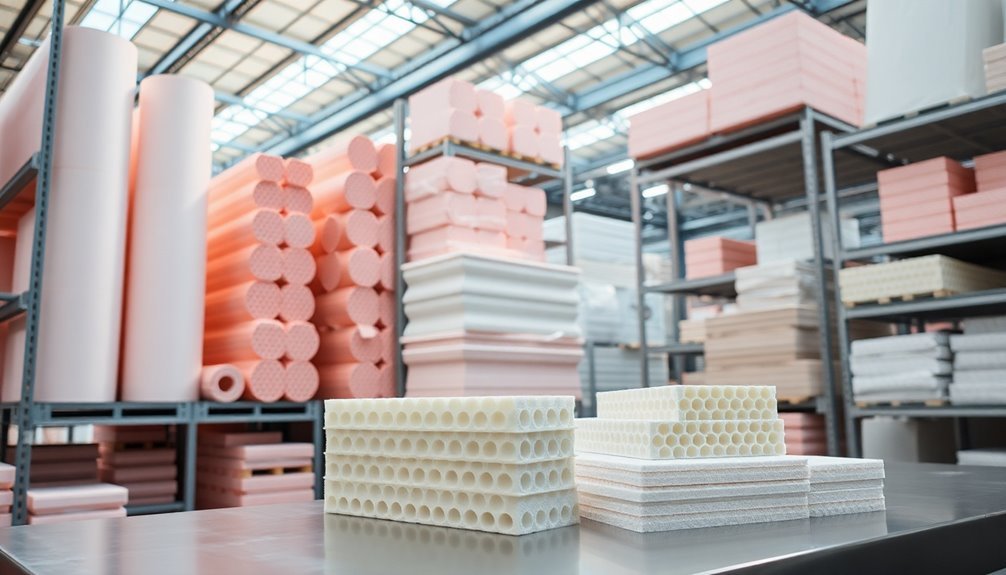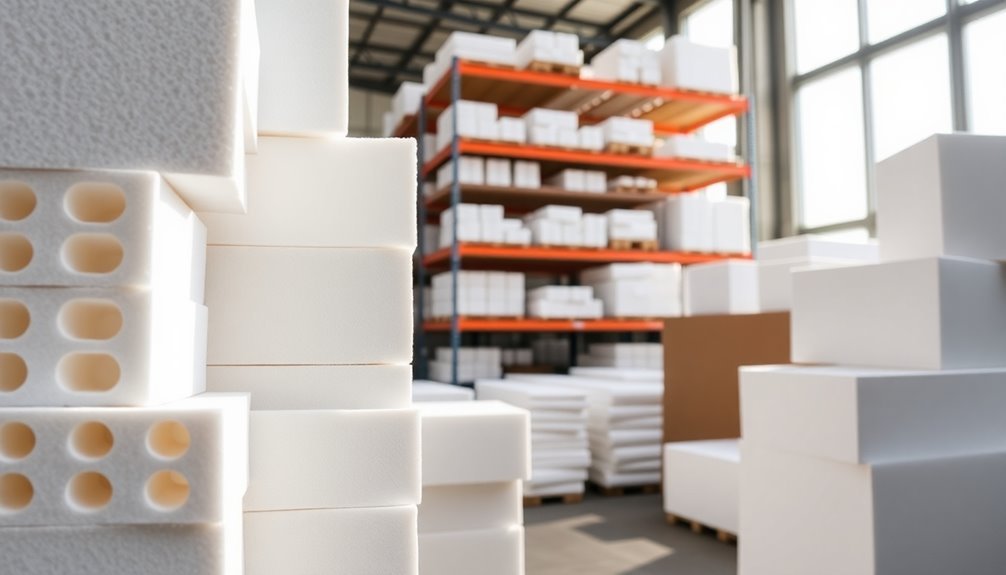You'll find several leading suppliers dominating the protection-grade foam market. Sealed Air Corporation offers extensive protective solutions including recyclable bubble mailers, while Flextech provides custom-engineered foam for medical, military, and aerospace applications. Deluxe Packaging specializes in polyurethane, polystyrene, and polyethylene foams, and Thrust Industries excels in die-cut foam configurations. BlueRose Packaging rounds out the top providers with high-quality foam sheets for electronics and fragile items. Each supplier offers unique capabilities in anti-static solutions, customization services, and sustainable options. Understanding their specific strengths will help you make the best choice for your packaging needs.
Market Leaders in Protection-Grade Foam

Several industry giants dominate the protection-grade foam market, with Sealed Air Corporation and Storopack Hans Reichenecker GmbH leading the pack. Sealed Air Corporation stands out for its extensive array of protective solutions, including mailers, bubble packs, and foam inserts, while Storopack specializes in custom-tailored foam products for diverse industries.
Sonoco Products Company has established itself as a major player, offering protective packaging solutions that cater specifically to electronics and automotive sectors. Many of these solutions incorporate polyethylene Ethafoam that meets stringent military requirements.
If you're looking for military-grade foam packaging, Atlas Foam Products delivers solutions that meet strict military specifications, including MIL-P-26514 and FAR 25.853(a).
The Nefab Group rounds out the top suppliers with their expertise in custom-built protective packaging, particularly using polyethylene and polyurethane foams.
These market leaders are expanding their presence globally, with the protective packaging market projected to grow at a 5.1% CAGR through 2030. While the Asia Pacific region currently holds the largest market share at 41.88%, North America's expected to take the lead in foam protective packaging, driven by strong demand from automotive and electronics industries.
Types of Anti-Static Packaging Solutions
Numerous anti-static packaging solutions protect sensitive electronic components from electrostatic discharge (ESD) damage. You'll find various types of anti-static bags, including dissipative bags made from PET plastic, conductive bags with aluminum layers, and metalized bags that create a Faraday cage effect. Even a 30-volt discharge can cause irreparable damage to sensitive electronics.
For less critical applications, you can opt for pink anti-static bags or black carbon-infused bags that provide partial shielding.
When it comes to foam solutions, you've got several options. PE foam offers a closed-cell structure with no odor, while EVA foam provides flexibility up to 50mm thickness. For heavy-duty protection, EPE foam can reach 80mm thickness, and PU foam delivers both flexibility and protection at 50mm thickness.
You can also consider specialized packaging materials like anti-static bubble wrap and bubble bags for shipping electronics. If you're looking for structural solutions, there's cardboard with anti-static coatings for boxes and dividers, and carbon-loaded corrugated plastic that's suitable for clean room environments.
Each solution offers different levels of protection, from simple static dissipation to complete ESD shielding, allowing you to choose based on your specific needs.
Customized Foam Protection Services

Through specialized fabrication processes, custom foam protection services deliver tailored solutions for your unique packaging needs. These services focus on creating precise cushioning and securement solutions that protect your products against shock, vibration, and potential damage during transport or storage.
The fabrication process begins with a thorough assessment of your product's specifications, including size, weight, and special requirements. Suppliers will select the most appropriate foam material and create a prototype that undergoes rigorous testing, including drop, vibration, and compression tests. The solutions are designed to meet highest industry standards for security and reliability.
They'll refine the design based on test results, adjusting thickness or density to guarantee maximal protection.
The market for custom foam protection is experiencing steady growth, with a projected 3.3% CAGR from 2024 to 2032. You can work with leading suppliers like Sonoco Products Company, Storopack Hans Reichenecker GmbH, and Supreme Industries Limited to develop your custom solutions.
These companies provide extensive design and engineering services, guaranteeing your products receive maximum protection. Whether you're shipping medical equipment, consumer electronics, or other fragile items, you'll find custom foam fabrication services that meet your specific packaging requirements.
Regional Supply Chain Distribution
While custom foam solutions serve individual packaging needs, understanding regional supply chain distribution reveals broader market dynamics and opportunities.
You'll find that Asia Pacific dominates the protective packaging landscape, holding over 34.72% market share, with China leading the region due to its robust healthcare sector growth and other factors such as rapid industrialization and the expansion of the e-commerce sector. The market is experiencing substantial growth, projected to reach USD 48.54 billion by 2033.
Europe's supply chain focuses heavily on sustainability, with countries implementing strict recycling targets and regulations like Germany's Green Dot Act. You're operating in a market where environmental consciousness meets practical protection needs, especially in the growing e-commerce sector.
Regional Focus
- North American distribution channels: Emphasize e-commerce platforms like Amazon and Shein, where you'll need to follow specific packaging guidelines.
- Central and South American markets: Prioritize medical-grade protection, with agencies like ANVISA enforcing strict healthcare packaging standards.
- Asia Pacific's electronics manufacturing hubs: In countries such as China, India, Japan, and South Korea, drive significant demand for protective foam solutions.
When sourcing protective packaging foam, you'll want to take into account these regional differences in regulations, market demands, and distribution networks to optimize your supply chain strategy and meet local requirements effectively.
Sustainable Packaging Innovations

Today's packaging industry's push toward sustainability has revolutionized protective foam solutions with groundbreaking alternatives. You'll find innovative materials like mushroom-based packaging, which uses agricultural waste bound by mycelium to create protective elements that fully decompose. These sustainable options don't compromise on protection while addressing environmental concerns. Smart packaging designs incorporate real-time shelf life sensors to monitor product integrity during shipping. You'll notice these alternatives are gaining traction as e-commerce growth drives demand for protective packaging solutions. Market competition has accelerated development of these sustainable materials, while global regulations continue to push suppliers toward eco-friendly options. When you're sourcing protective packaging, you'll find these innovations offer comparable protection to traditional foams while meeting environmental standards and consumer expectations for sustainability.
| Material Type | Decomposition Time | Key Benefits |
|---|---|---|
| Mushroom Foam | 30-90 days | Fully compostable, custom-moldable |
| Hemp-Based Biodegradable | 6 months | Landfill decomposable, durable |
| Seaweed Solutions | 3-6 months | Water-soluble, edible options |
| Cellulose Packaging | 3-4 months | Natural source materials, versatile |
| Recycled Flexible Foam | Recyclable | Works with existing infrastructure
Essential Product Specifications
Several critical specifications determine the effectiveness of protective packaging foam, with material classifications playing a fundamental role. You'll find three primary foam classes: polyethylene plank materials for cushioning, polypropylene plank materials for varied applications, and general-purpose plank materials for broader uses. Each class must comply with MIL STD CID A-A-59136 standards, ensuring reliable performance in protective packaging applications. Different grades of treatment are available, including standard, anti-static, and fire retardant options.
When selecting protective foam, you'll need to take into account these essential specifications:
- Compression creep tolerance – Your foam shouldn't exceed 10% of initial thickness after 168 hours of testing.
- Load capacity types (I-IV) – Choose between 14 kg to 37 kg weight limitations based on your packaging needs.
- Density and thickness requirements – Match these to your product's fragility, weight, and dimensions.
The material's performance is measured through cushioning curves, which show the best g-limit performance at specific drop heights and weights.
You'll want to pay close attention to fragility classifications, as they'll guide your foam selection. For instance, if you're packaging extremely delicate items, you'll need foam with superior shock absorption properties, like polyurethane, which offers excellent protection for sensitive components.
Industry-Specific Foam Applications

Each major industry requires specialized foam applications tailored to its unique challenges and protection needs. In construction and manufacturing, you'll find foam materials serving multiple purposes, from lightweight insulation and soundproofing to critical structural elements and safety padding. Advanced fabrication methods like CNC machining and thermoforming ensure precise foam components for these industries.
The material's versatility extends to gaskets and seals, making it invaluable for various manufacturing processes.
The automotive and aerospace sectors rely heavily on foam for seat cushions, dashboard components, and lightweight structural supports. You'll see it used extensively for reducing vibration and noise while contributing to vehicle safety through impact-resistant properties.
In aerospace applications, foam's lightweight nature helps reduce aircraft weight without compromising durability.
For packaging and e-commerce, you'll need custom foam inserts, pre-cut boards, and sheets to protect delicate items during shipping. These solutions are particularly vital for electronics and pharmaceutical industries, where product protection is paramount.
You can utilize specialized foam packaging to safeguard sensitive medical devices, electronic components, and high-value pharmaceutical products. Whether you're shipping fragile electronics or temperature-sensitive medications, foam's protective properties make it an essential component in your packaging strategy.
Quality Standards and Certifications
Quality control benchmarks in protective foam manufacturing guarantee your products meet rigorous industry standards. When you're sourcing protective packaging foam, you'll need to verify that your supplier maintains key certifications like MIL-SPEC for military-grade durability, ASTM D3574 for physical properties testing, and FDA compliance for food-service applications. The MIL STD CID A-A-59136 specification is crucial for ensuring military-grade packaging materials meet stringent durability requirements.
Your foam supplier should demonstrate thorough quality assurance through:
- Raw material testing and verification, confirming consistent foam production that meets your specifications
- Continuous process monitoring with precise control of chemical reactions and curing procedures
- Regular third-party laboratory testing to validate compliance with industry standards like ASTM E84 and CertiPUR-US
You'll find that suppliers maintaining these certifications typically deliver superior products that protect your items during shipping and storage.
Look for manufacturers who participate in independent verification programs and maintain detailed documentation of their testing procedures. The CertiPUR-US certification is particularly important if you're seeking flexible polyurethane foams, as it confirms the absence of harmful chemicals and confirms consistent performance.
These standards aren't just bureaucratic requirements – they're your assurance of receiving protection-grade foam that performs reliably in your specific application.
Global Market Growth Trends

As the global protective packaging market surges toward USD 48.54 billion by 2033, you'll find expanding opportunities in foam supply across diverse regions. The Asia Pacific market leads with a 34.72% share, driven by rapid e-commerce growth and increasing consumer spending. You'll notice the foam packaging segment's particularly strong performance, projected to reach USD 32.50 billion by 2034.
| Region | Key Driver | Market Outlook |
|---|---|---|
| Asia Pacific | E-commerce Expansion | Leading at USD 11.24B (2024) |
| North America | Packaging Giants | Second Largest Share |
| Europe | On-the-Go Products | Strong Growth Expected |
| U.S. | E-commerce Platforms | USD 14.80B by 2032 |
| Latin America | Perishable Items | Steady Growth |
If you're exploring market opportunities, you'll want to focus on the foam packaging sector, which is experiencing a robust CAGR of 5.35%. The industry's growth is further supported by technological advancements in materials like inflatable air cushions and molded foam inserts. With e-commerce continuing its expansion and sustainable packaging solutions gaining traction, you'll find the protective packaging market particularly dynamic in emerging economies like China and India.
Frequently Asked Questions
What Is the Minimum Order Quantity for Wholesale Foam Packaging Products?
You'll find minimum order quantities vary by supplier: BlueRose and Foam Packaging have no minimums, Emenac requires 25 units for custom foam inserts, while Urgent Boxes sets their minimum at 100 units.
How Long Does Protection-Grade Foam Maintain Its Cushioning Properties During Storage?
You'll find protection-grade foam maintains its cushioning properties for 2-5 years when stored properly. Keep it away from extreme temperatures, moisture, and direct sunlight to maximize its lifespan and performance.
Can Packaging Foam Be Recycled Through Standard Municipal Recycling Programs?
You can't recycle foam through most standard municipal programs. Due to its low density and processing challenges, only about 6% of consumer foam packaging gets recycled. You'll need to find specialized foam recycling facilities.
What Temperature Ranges Can Different Types of Protective Foam Safely Withstand?
You'll find most protective foams can handle temperatures from -200°F to 240°F once cured. Spray foams work best between 60-80°F during application, while EPS and PUR foams excel in cold chain shipping.
Are There Special Cleaning Requirements for Maintaining Protection-Grade Foam Products?
You'll need to regularly clean your protective foam with mild soap and water, avoid harsh chemicals, and guarantee thorough drying. For specialized foams containing PFAS, follow strict environmental protocols and disposal guidelines.
In Summary
You'll find today's protection-grade foam packaging market offers more solutions than ever before. Whether you're seeking anti-static materials, custom-cut designs, or sustainable options, leading suppliers can meet your specific needs. Stay competitive by partnering with certified manufacturers who understand your industry requirements. Don't hesitate to explore the growing global market for innovative packaging solutions that'll protect your products effectively.





Leave a Reply